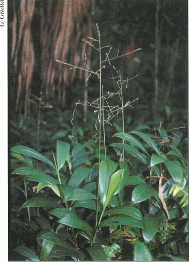Phascinating Pharus
Gerald “Stinger” Guala, Ph.D., Former Keeper of the Herbarium
 |
| To Florida residents, the most important thing about this grass, Pharus glaber, is its rarity. |
One of the most interesting plants in the Fairchild Tropical Botanic Garden conservation collection is Pharus glaber Kunth. Pharus and its close relatives leptaspis and Scrotochloa branched off from the rest of the grasses very early in the evolution of the family and now have their own subfamily, the Pharoideae. Emmet Judziewicz, who revised the Pharoideae for his Ph.D., points out that there are fossils of leptaspis from Kenya that are 12 million years old.
Pharus, which has very wide leaves, looks more like a member of the banana family than it does a grass. Curiously, the leaves are upside down, the only members of the grass family with this characteristic. All of the hairs and other anatomical characteristics that are on the top side of other grass leaves are on the underside in Pharus.
They are also full of cyanogenic compounds. This plant gives a stronger positive reaction for cyanogenic compounds than any other grass that I have ever tested, although I know of a certain cat who has eaten several leaves with no ill effects. A little hood on the tip of the flowers gives the genus its name. Pharos is derived from pharos, the Greek word for cloak or hood.
The more obvious characteristic to anyone who has ever walked through a fruiting population of Pharus is that its fruit are covered with uncinate (hooked) hairs that allow them to stick to your clothes so tightly that often they do not even come off in the wash.
There are a lot of interesting things about this grass, but maybe the most important thing to Florida residents is its rarity. This beautiful grass was once found in several places in Florida, however, extensive surveys over the years have located only one remaining population. In fact, it was long thought to be extinct in Florida because it had not been collected here since the 1920s. As a graduate student, I spent many long days in the field looking for it, only to have it brought to me for identification one day in 1995. Steve Riefler, an amateur botanist, had collected it and gave a piece to Nang Bissett, a native plant grower, who took it to David Hall at the University of Florida for identification. I think that David recognized it immediately, but he showed it to me because he knew that, like him, I had spent a great deal of time looking for it. Since it is found in much of South America, I didn't think much of the specimen until I looked at the label and realized that it was the great lost species that we thought was extirpated from Florida. After seeing the specimen, Carol Lippincott (Fairchild Tropical Garden's former Curator of Endangered Species) and I went out to collect official vouchers, take soil samples and characterize the habitat of the only known population of Pharus glaber in North America. This information was essential in persuading the Endangered Plant Advisory Council that the species was indeed extant in Florida and should be declared endangered here. They did this during a meeting held at Fairchild Tropical Garden in November, 1999.
The final twist in this story is that a few years before the species was rediscovered in the wild, convinced that Pharus glaber was gone from Florida forever, I brought in seed from Brazil, put it through quarantine, and distributed it through the Caribbean Chapter of the American Bamboo Society.
With the rediscovery of native Pharus, we now had a problem. I can tell the native plants from the non-native ones by their habit and leaf size but the characteristics are so subtle that a more definitive way to separate them was needed. My graduate student Nicole Andrus provided the answer. With the help of David Bogler in Javier Francisco-Ortega's molecular lab at the Fairchild Research Center, she examined AFLP and microsatellite DNA characteristics for our native material and several other populations from South America and found differences between the Florida plants and the Brazilian plants. The sample size is too small to be conclusive, but when combined with the morphological characteristics, it provides us with a good way to determine which Pharus is which. Nicole and I gave a talk on the data at the 2000 Florida Native Plant Society meeting here in Miami, and a treatment of our species that I coauthored with Emmet Judziewicz is due out soon in the new Manual of Grasses for North America North of Mexico, and in the Flora of North America.
Garden Views November 2001